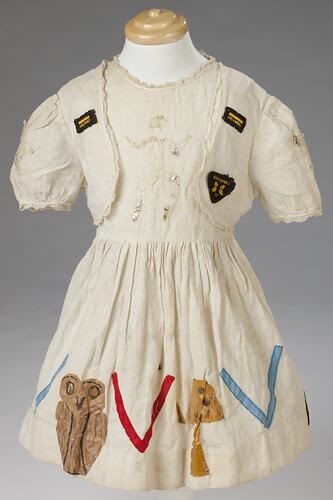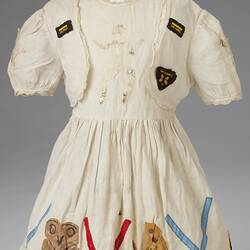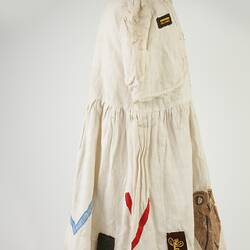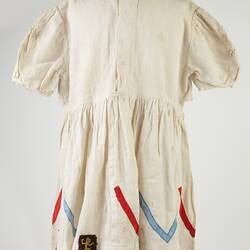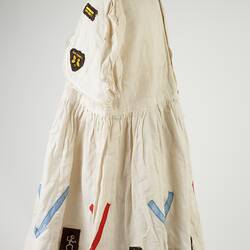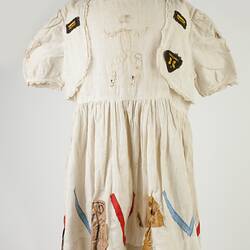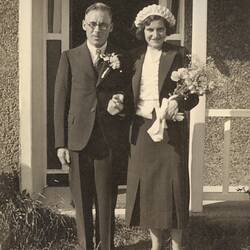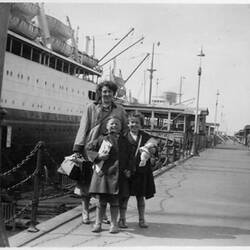Summary
White cotton child's dress worn by Hazel Hathaway for the Victory in Europe street party celebrations in Coventry, England on 8 May 1945. The dress was amongst many personal items brought to Australia when the Hathaway family migrated in 1951. It was made by Hazel's mother Lucy Hathaway and decorated with Brownie badges as Lucy was the Captain of the Congregational Church Girl Guides in Coventry. As Hazel was only a child during World War II she accompanied her mother to all the Brownie, Guide and Ranger events as Lucy wanted Hazel with her if a raid occurred. Victory in Europe Day commemorates 8 May 1945, when the World War II Allies formally accepted the unconditional surrender of the armed forces of Germany. On that day celebrations took place across Europe and North America; in London over a million people celebrated the end of the European war.
This dress was a precious symbol for the Hathaway family of the experiences of thousands of post-war assisted migrants from England who brought with them memories of danger, sadness, courage, austerity and celebration in both tangible and intangible forms. The Hathaways survived one of the most severe bombings of any English city during World War II and this VE dress is a material symbol of endurance and triumph. It was carefully looked after and valued by the family until the younger daughter Merle donated it to the Museum.
Merle reflected in 2017: "This is the little dress my mother made for my sister to wear at the VE celebration in Coventry when peace was declared...it's very sweet and I don't know where she would have got the material, it looks like an Indian cotton...when I found it most recently it was wrapped in tissue paper and in with it was a Union Jack flag and a clipping from the declaration of victory...so a little time capsule really and I did mention to my mother that perhaps it should go to a museum...so it's lovely that it is here now in this collection."
Stanley and Lucy (nee Simmons) Hathaway and their daughter Hazel survived World War II in heavily bombed Coventry, England, remaining there until 1946. They attended the Victory in Europe Day (VE Day) celebrations there on 8 May 1945. The Hathaways relocated to Buckinghamshire (where second daughter Merle was born in 1948) and Hampshire between 1946 and 1951, finally deciding to migrate to Australia. They applied successfully to the Assisted Passage Migration Scheme but had to wait two years before departing, living and touring England in a caravan until departing on the 'New Australia' 17 November 1951. They first stayed at the Bathurst Migrant Camp in New South Wales before being relocated to a housing commission estate in Ballarat, Victoria. Within six months they had purchased a block of land, living in a caravan while their house was built. The family became active members of the local Ballarat community, with Lucy working for the newly established McCallum House Centre for Retarded Children at Sebastopol and continued her strong interest in the Brownies and Girl Guides associations.
Physical Description
Off white cotton child's dress consisting of a joined bolero with lace trim, connected to a full skirt and bodice, with puffed sleeves. The dress is decorated with blue and red ribbon 'V' pattern surrounding the hem, in alternate red and blue ribbon. Girl Guide patches are stitched to the bolero and dress, depicting bees and various figures. The patches are brown with yellow text. A brown paper owl, hand decorated with black pencil is stitched to the hem. The remnants of a foil figure can be seen on the bodice. Most of the foil has fallen away, but some remains on the legs of the figure.Three press studs down the back. Remnants of paper decorative shapes are stitched to each sleeve.
Significance
Statement of Historical Significance:
This collection represents the experiences of thousands of post-war assisted migrants from England who brought with them memories of danger, sadness, courage, austerity and celebration in both tangible and intangible forms. This family survived one of the most severe bombings of any English city during World War II and brought with them material symbols of endurance and triumph in the Victory Day dress and Union Jack flag, symbols with almost universal resonance. The collection also includes items which tell stories about the goods migrants select in order to start new lives, the adventure of the ship voyage, and the seeking of familiar interests in a new community. The collection also explores the theme of maintaining connections and loyalties to homeland, in this case through memorabilia relating to the British monarchy and exchange projects with former local communities.
More Information
-
Collecting Areas
Migration & Cultural Diversity, Clothing & Textiles, Childhood, Public Life & Institutions
-
Acquisition Information
Donation from Merle Hathaway, 28 May 2010
-
User
Hazel Hathaway, Coventry, England, Great Britain, 8 May 1945
-
Other Association (See Comments)
Mrs Lucy J. Hathaway, Coventry, England, Great Britain, May 1945
Decorator of the dress -
Inscriptions
Stitched in yellow on fabric patches on the bodice: 'GIRL GUIDES'.
-
Classification
-
Category
-
Discipline
-
Type of item
-
Overall Dimensions
560 mm (Height)
Neck to hem.
-
Overall Dimensions
250 mm (Height)
Neck to waist
-
Overall Dimensions
520 mm (Width)
Sleeve to sleeve.
-
Keywords
British Immigration, Brought Goods, Celebrations, Children's Clothing, Migration & Settlement, World War II, 1939-1945, Migrant Camps, Migrant Reception Centres
